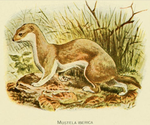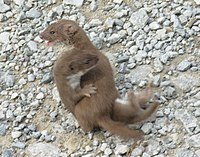Least weasel
| Least weasel Temporal range: Late Pleistocene – Recent
| |
|---|---|
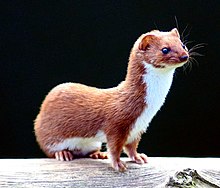
| |
| Least weasel at the British Wildlife Centre, Surrey, England | |
| Scientific classification | |
| Domain: | Eukaryota |
| Kingdom: | Animalia |
| Phylum: | Chordata |
| Class: | Mammalia |
| Order: | Carnivora |
| Family: | Mustelidae |
| Genus: | Mustela |
| Species: | M. nivalis
|
| Binomial name | |
| Mustela nivalis | |

| |
| Global range of the least weasel | |
The least weasel (Mustela nivalis), little weasel, common weasel, or simply weasel is the smallest member of the
The least weasel varies greatly in size over its range. The body is slender and elongated, and the legs and tail are relatively short. The colour varies geographically, as does the
Small rodents form the largest part of the least weasel's diet, but it also kills and eats rabbits, other mammals, and occasionally birds, birds' eggs, fish and frogs. Males mark their territories with olfactory signals and have exclusive home ranges which may intersect with or include several female ranges. Least weasels use pre-existing holes to sleep, store food and raise their young. Breeding takes place in the spring and summer, and there is a single litter of about six kits which are reared exclusively by the female. Due to its small size and fierce nature, the least weasel plays an important part in the mythology and legend of various cultures.
Taxonomy and evolution
The least weasel was given its scientific name Mustela nivalis by Carl Linnaeus in his
Within the genus Mustela, the least weasel is a relatively unspecialised form, as evidenced by its
Subspecies
The least weasel has a high geographic variation, a fact which has historically led to numerous disagreements among biologists studying its systematics. The least weasel's subspecies are divided into three categories:[9]
- The pygmaea–rixosa group (small least weasels): Tiny weasels with short tails, pedomorphic skulls, and pelts that turn pure white in winter. They inhabit northern European Russia, Siberia, the Russian Far East, Finland, the northern Scandinavian Peninsula, Mongolia, northeastern China, Japan and North America.[9]
- The boccamela group (large least weasels): Very large weasels with large skulls, relatively long tails and lighter coloured pelts. Locally, they either do not turn white or only partially change colour in winter. They inhabit Middle Asia. They are also found in Morocco, Algeria, and Tunisia.[9]
- The nivalis group (medium-sized least weasels): Medium-sized weasels, with tails of moderate length, representing a transitional form between the former two groups. They inhabit the middle and southern regions of European Russia,
| Subspecies | Trinomial authority | Description | Range | Synonyms |
|---|---|---|---|---|
| Common least weasel M. n. nivalis ( Nominate subspecies )
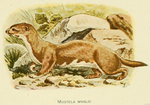
|
Linnaeus, 1766 | A medium-sized subspecies with a tail of moderate length, constituting about 20–21% of its body length. In its summer fur, the upper body is a dark brownish or chestnut colour, while its winter fur is pure white. It is probably a transitional form between the small pygmaea and the large vulgaris.[10] | The middle regions of Hokkaidō .
|
caraftensis (Kishida, 1936) kerulenica (Bannikov, 1952) |
| Allegheny least weasel M. n. allegheniensis |
Rhoads, 1901 | Similar to M. n. rixosa, but is larger, has a broad skull and darker coat, and is more adapted to live in deciduous forests[11] | The northeastern United States (Michigan, Pennsylvania, New York, Virginia, North Carolina, Ohio, Illinois, Wisconsin, West Virginia, and Indiana) | |
| Transcaucasian least weasel M. n. boccamela |
Bechstein, 1800 | A very large subspecies, with a long tail constituting about 30% of its body length. In its summer fur, the upper body is light brownish or chestnut with yellowish or reddish tints, with some individuals having a brownish dot on the corners of the mouth and sometimes on the chest and belly. The winter fur is not pure white, being usually dirty white with brown patches.[12] | Asia Minor and probably western Iran
|
italicus (Barrett-Hamilton, 1900) |
| Plains least weasel M. n. campestris |
Jackson, 1913 | The Great Plains of the United States (South Dakota, Iowa, Nebraska, and Kansas) | ||
| Caucasian least weasel M. n. caucasica |
Barrett-Hamilton, 1900 | dinniki (Satunin, 1907) | ||
| Alaskan least weasel M. n. eskimo |
Stone, 1900 | A small subspecies. Resembles M. n. rixosa, but has a duller colour, a larger skull and a shorter tail.[13] | Alaska, the Yukon, and the Northwest Territories | |
| Turkmenian least weasel M. n. heptneri |
Morozova-Turova, 1953 | A very large subspecies with a long tail constituting about 25–30% of its body length. In its summer fur, the upper body is very light sandy brown or pale-yellowish. The fur is short, sparse and coarse, and does not turn white in winter.[14] | The deserts and semi-deserts of southern Koppet Dag, Afghanistan and northeastern Iran
|
|
| Japanese least weasel M. n. namiyei |
Kuroda, 1921 | Smaller than M. n. rixosa and paler than M. n. eskimo. Resembles M. n. pygmaea, but the head and body are longer and the tail considerably longer.[15] | Northern Prefectures) | |
| Mediterranean least weasel M. n. numidica |
Pucheran, 1855 | The largest subspecies | Azores Islands and Corsica
|
albipes (Mina Palumbo, 1868) algiricus (Thomas, 1895) |
| Montane Turkestan least weasel M. n. pallida |
Barrett-Hamilton, 1900 | A medium-sized subspecies with a tail constituting about 24% of its body length. The colour of the summer fur is light-brownish, while the winter fur is white.[16] | The montane parts of Hindukush
|
|
| Siberian least weasel M. n. pygmaea |
J. A. Allen, 1903 | A very small subspecies, with a short tail which constitutes about 13% of its body length. In its summer coat, the dorsal colour is dark brown or reddish, while the winter fur is entirely white.[17] | All of | kamtschatica (Dybowksi, 1922) |
| Bangs' least weasel M. n. rixosa |
Bangs, 1896 | The smallest subspecies and the smallest living mammalian carnivore in the world. In its summer coat, the fur is dark reddish-brown, while the winter fur is pure white.[18] | Nunavut, Labrador, Quebec, Minnesota, North Dakota, Montana, Saskatchewan, Alberta, and British Columbia | |
| Middle European least weasel M. n. vulgaris |
Erxleben, 1777 | A somewhat larger subspecies than nivalis with a longer tail, which constitutes about 27% of its body length. In its summer fur, the upper body varies from being light brownish to dark chestnut, while the winter fur is white in its northern range and piebald in its southern range.[19] | Southern European Russia from the latitude of southern Voronezh and Kursk districts, | dumbrowskii (Matschie, 1901) hungarica (Vásárhelyi, 1942) |
Description
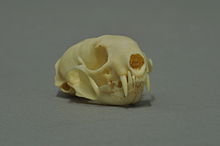


The least weasel has a thin, greatly elongated and extremely flexible body with a small, yet elongated, blunt-muzzled head which is no thicker than the neck. The eyes are small in relation to their head size and are bulging and dark colored. The legs and tail are relatively short, the latter constituting less than half the body length. The feet have sharp, dark-coloured claws, and the
The weasel has a stronger bite force than a lion, tiger, hyena, or even a bear, relative to body size. A combination of shorter jaws, powerful muscles, and the placement of its teeth allows the weasel to have tremendous power when it snaps its jaws shut.[26]
The baculum is short, 16 to 20 mm (0.6 to 0.8 in), with a thick, straight shaft. Fat is deposited along the spine, kidneys, gut mesentries and around the limbs. The least weasel has muscular anal glands under the tail, which measure 7 by 5 mm (0.3 by 0.2 in), and contain sulphurous volatiles, including thietanes and dithiacyclopentanes. The smell and chemical composition of these chemicals are distinct from those of the stoat.[25] The least weasel moves by jumping, the distance between the tracks of the fore and hind limbs being 18 to 35 cm (7 to 14 in).[27]

Dimensions vary geographically, to an extent rarely found among other mammals. Least weasels of the boccamela group, for example, may outweigh the smaller races by almost four times. In some large subspecies, the male may be 1.5 times longer than the female. Variations in tail length are also variable, constituting 13 to 30 percent of the length of the body. Average body length in males is 130 to 260 mm (5 to 10 in), while females average 114 to 204 mm (4.5 to 8.0 in). The tail measures 12 to 87 mm (0.5 to 3.4 in) in males and 17 to 60 mm (0.7 to 2.4 in) in females. Males weigh 36 to 250 g (1.3 to 8.8 oz), while females weigh 29 to 117 g (1.0 to 4.1 oz).[28]

The winter fur is dense, but short and closely fitting. In northern subspecies, the fur is soft and silky, but coarse in southern forms. The summer fur is very short, sparser and rougher. The upper parts in the summer fur are dark, but vary geographically from dark-tawny or dark-chocolate to light pale tawny or sandy. The lower parts, including the lower jaw and inner sides of the legs, are white. There is often a brown spot at the corner of the mouth. The dividing line between the dark upper and light lower parts is usually straight but sometimes forms an irregular line. The tail is brown, and sometimes the tip is a little darker but it is never black. In the northern part of its range and at high altitudes, the least weasel changes colour in the winter, the coat becoming pure white and exhibiting a few black hairs in rare circumstances.[24][29]
Fossil record
Fossilised remains of the least weasel are known from Denisova Cave.[30]
Behaviour and ecology
Reproduction and development
The least weasel mates in April–July and there is a 34- to 37-day
The female raises its kits without help from the male. They are 1.5 to 4.5 g (0.05 to 0.16 oz) in weight at birth. Newborn kits are born pink, naked, blind and deaf, but gain a white coat of downy fur at the age of 4 days. At 10 days, the margin between the dark upper parts and light under parts becomes visible. The
Territorial and social behaviours
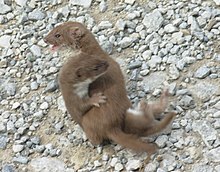
The least weasel has a typical mustelid territorial pattern, consisting of exclusive male ranges encompassing multiple female ranges. The population density of each territory depends greatly on food supply and reproductive success, thus the social structure and population density of any given territory is unstable and flexible.
The least weasel has four basic vocalisations; a guttural hiss emitted when alarmed, which is interspersed with short screaming barks and shrieks when provoked. When defensive, it emits a shrill wail or squeal. During encounters between males and females or between a mother and kits, the least weasel emits a high-pitched trilling. The least weasel's way of expressing aggression is similar to that of the stoat. Dominant weasels exhibit lunges and shrieks during aggressive encounters, while subdominant weasels will emit submissive squeals.[33]
Diet

The least weasel feeds predominantly on
Despite its small size, the least weasel is a fierce hunter, capable of killing a rabbit five to 10 times its own weight.[37] Although they are commonly taken, the rabbits are usually young specimens, and become an important food source during the spring, when small rodents are scarce and rabbit kits are plentiful. Male least weasels take a higher proportion of rabbits than females, as well as an overall greater variety of prey. This is linked to the fact that being larger, and having vaster territorial ranges than females, males have more opportunities to hunt a greater diversity of prey.[38]
The least weasel forages undercover, to avoid being seen by foxes and birds of prey. It is adapted for pursuing its prey down tunnels, though it may also bolt prey from a burrow and kill it in the open.
Predators and competitors

The least weasel is small enough to be preyed upon by a range of other predators.
In areas where the least weasel is sympatric with the stoat, the two species compete with each other for rodent prey. The weasel manages to avoid too much competition by living in more upland areas, feeding on smaller prey and being capable of entering smaller holes. It actively avoids encounters with stoats, though female weasels are less likely to stop foraging in the presence of stoats, perhaps because their smaller size allows them to quickly escape into holes.[41]
Diseases and parasites
Distribution and habitat

The least weasel has a
The least weasel occupies a similar type of habitat as the stoat, but it frequents wet places less often. It can be found in fields, open woodland, bushy or rocky areas, parks and gardens, and at altitudes of up to about 3,000 metres (9,800 ft).[29]
Conservation status
The least weasel has a very wide circumboreal range and a large total population and is therefore listed by the
In folklore and mythology
Macedonian and Greek culture

The
Similarly, a popular superstition in southern Greece had it that the least weasel had previously been a bride, who was transformed into a bitter animal which would destroy the wedding dresses of other brides out of jealousy.[44] According to Pliny the Elder, the least weasel was the only animal that was capable of killing the basilisk:
To this dreadful monster the effluvium of the weasel is fatal, a thing that has been tried with success, for kings have often desired to see its body when killed; so true is it that it has pleased Nature that there should be nothing without its antidote. The animal is thrown into the hole of the basilisk, which is easily known from the soil around it being infected. The weasel destroys the basilisk by its odour, but dies itself in this struggle of nature against its own self.[45]
Ojibwe and Inuit culture
The Ojibwe believed that the least weasel could kill the dreaded wendigo by rushing up its anus.[46]
In
See also
References
Citations
- ^ . Retrieved 18 February 2022.
- PMID 21056828.
- ^ doi:10.2307/3504183.
- ISBN 978-0-8018-8221-0.
- S2CID 17450300.
- ^ Heptner & Sludskii 2002, p. 972
- ^ Kurtén 1968, pp. 102–103
- ^ Macdonald 1992, p. 205
- ^ a b c d Heptner & Sludskii 2002, pp. 975–978
- ^ Heptner & Sludskii 2002, p. 982
- JSTOR 4062685.
- ^ Heptner & Sludskii 2002, p. 980
- JSTOR 1373581.
- ^ Heptner & Sludskii 2002, p. 981
- JSTOR 1373554.
- ^ Heptner & Sludskii 2002, p. 984
- ^ Heptner & Sludskii 2002, p. 978
- ^ Merriam 1896, pp. 14–15
- ^ Heptner & Sludskii 2002, p. 983
- ^ ISBN 9780643099166
- ISBN 0-19-558477-5.
- ^ Fergus, Chuck. "Weasels" (PDF). Pennsylvania Game Commission. Retrieved 8 November 2017.
- ^ Heptner & Sludskii 2002, pp. 967–969
- ^ a b Heptner & Sludskii 2002, p. 969
- ^ a b Harris & Yalden 2008, p. 468
- ^ "The Most Powerful Bite | Weasels: Feisty & Fearless | BBC Earth". YouTube.
- ^ Heptner & Sludskii 2002, p. 991
- ^ Heptner & Sludskii 2002, pp. 970–972
- ^ ISBN 978-0-00-212080-7.
- . Retrieved 13 January 2024 – via Elsevier Science Direct.
- ^ a b Harris & Yalden 2008, p. 474
- JSTOR 3543948.
- ^ a b Harris & Yalden 2008, pp. 471–472
- ^ a b Merritt & Matinko 1987, p. 277
- ^ a b c Heptner & Sludskii 2002, pp. 987–988
- JSTOR 4182.
- ^ Macdonald 1992, p. 208
- ^ a b c Harris & Yalden 2008, pp. 472–473
- ^ a b c d Harris & Yalden 2008, p. 475
- ^ Heptner & Sludskii 2002, p. 992
- ^ Harris & Yalden 2008, p. 469
- .
- S2CID 20057808.
- ^ Abbott, G. A. (1903), Macedonian Folklore, pp. 108–109, Cambridge University Press
- ^ Pliny the Elder (1855). John Bostock; Henry Thomas Riley (eds.). "The Natural History". Retrieved 23 August 2022.
- ISBN 0-299-07314-9
- ISBN 1-4179-8416-3
General and cited references
- Harris, Stephen; Yalden, Derek (2008). Mammals of the British Isles (4th Revised ed.). Mammal Society. ISBN 978-0-906282-65-6.
- Kurtén, Björn (1968). Pleistocene mammals of Europe. Weidenfeld and Nicolson.
- Heptner, V. G.; Sludskii, A. A. (2002). Mammals of the Soviet Union. Vol. II, part 1b, Carnivores (Mustelidae and Procyonidae). Washington, D.C. : Smithsonian Institution Libraries and National Science Foundation. ISBN 90-04-08876-8.
- Macdonald, David (1992). The Velvet Claw: A Natural History of the Carnivores. New York: Parkwest. ISBN 0-563-20844-9.
- Merriam, Clinton Hart (1896). Synopsis of the weasels of North America. Washington, D.C.: Govt. Print. Off.
- Merritt, Joseph F.; Matinko, Ruth Anne (1987). Guide to the mammals of Pennsylvania. University of Pittsburgh Press. ISBN 0-8229-5393-5.
Further reading
- Coues, Elliott (1877). Fur-bearing Animals: A Monograph of North American Mustelidae. Government Printing Office.
- Johnston, Harry Hamilton (1903). British mammals; an attempt to describe and illustrate the mammalian fauna of the British islands from the commencement of the Pleistocene period down to the present day. London, Hutchinson.
- Kurtén, Björn (1980). Pleistocene mammals of North America. Columbia University Press. ISBN 0-231-03733-3.



